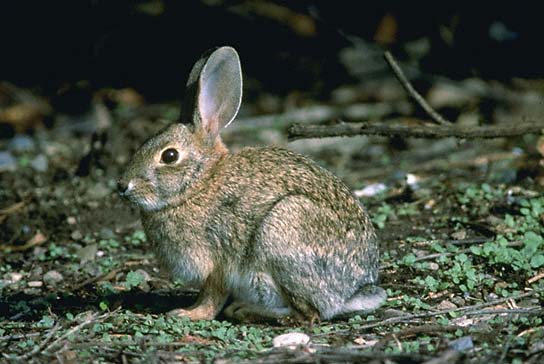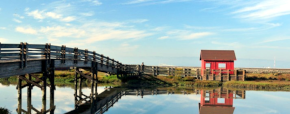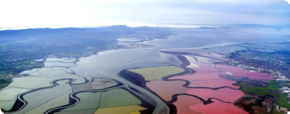Species & Wildlife

Want to learn more about the Don Edwards San Francisco Bay National Wildlife Refuge? Check out this quick and easy learning module to get to know the animal and plant species that call the Refuge home. Whether you learn more about Salty the Salt Marsh Harvest Mouse or watch a video of Snowy the Snowy Plover – there is something here for all ages to get excited about!
This special module was designed for the Refuge’s Marsh-In Summer campers, offering insights into the diverse wildlife and habitats of the San Francisco Bay Area.
If you are interested in learning more or want to know how you can apply your newfound knowledge to visiting the Refuge, please email watershedwatchers@sfbayws.org.
Interactive Slideshow
Refuge Species
Here are some of the animal and plant species that call the Refuge home:
Producers
Reptiles
Producers
What is a producer? Producers are green plants or organisms like phytoplankton that produce (make) their own food! Here are some that you’ll see around the marsh and slough:
Algae
What is algae? Algae is not an actual species, but an informal term for a large and diverse group of photosynthetic organisms in water.
Phytoplankton is a type of microscopic algae at the base of every water food chain. These “plants” get eaten by zooplankton and other small organisms, which in turn get eaten by fish, and so on.
Pickleweed
Pickleweed (scientific name: Salicornia) is a common plant that grows on salt marshes and beaches. It is a very important part of the wetlands food chains because it gets eaten by many animals, including Salty, the Endangered Salt Marsh Harvest Mouse! The presence of Pickleweed indicates the health of the salt marsh ecosystem.
Tule
Tule (scientific name: Schoenoplectus acutus) is a plant native to freshwater marshes all over North America.
Ohlone people use tule roots, pollen, and flowers as food. The spongy stems are used to make baskets and boats for fishing.
Birds
Western Snowy Plover *
This species is a threatened small shorebird, approximately the size of a sparrow. The Western Snowy Plover faces habitat loss and human disturbances, making conservation efforts crucial.
Predators: Falcons, raccoons, coyotes, owls, crows, dogs.
Freshly hatched chicks This small bird is at risk of becoming endangered because of habitat loss and human disturbances. Kites and drones look like predators to plovers, so when they fly away in fright, their babies become exposed to real predators.
California Ridgway’s Rail (Cali) *
Cali is an endangered species that currently only appears in the San Francisco Bay Estuary. The secretive nature of the California Ridgway’s Rail makes it challenging to observe in the wild.She is secretive and hard to observe, but if you’re lucky, you might see her hiding in the marsh!
Eggs: Usually 7-11, sometimes 5-12+. Incubation by both parents
Nest sites: In clump of grass or marsh vegetation, often with a ramp of plant material leading up from
ground.
Predators: Squirrels, rats, weasels, gray foxes, skunks
Diet: Crustaceans (crabs, crayfish), insects, fish.
American Avocet
Cheep, cheep! If you see a Black-necked Stilt (Recurvirostra americana), you might see American Avocets mixed in with them. American Avocets are known for their unique nesting behaviors and loud calls during breeding season
These birds breed in the Great Plains and are found along the coasts of California and Texas.
Eggs: 4, sometimes 3-5. Female incubates at night, both sexes take turns during day. Both parents tend to young, who self-feed and start flight around 4-5 wks old.
Nesting: Often form colonies. Aggressively and loudly protect nests, sometimes flying straight at intruders.
Life span: 9-15 years
Diet: Small crustaceans and insects, also seeds.
Black-Necked Stilt
Kek kek kek! Do you hear that? That’s our Black-necked stilt (Himantopus mexicanus). Black-necked Stilts are highly adaptable birds found in various wetland habitats across North America. You can often find a stilt parent with their babies in the shallow waters of the marsh!
Diet: Insects (brine flies, beetles) and crustaceans (shrimp, crayfish), sometimes tadpoles or tiny fish
Eggs: 4, sometimes 3-5. Both parents incubate eggs. Young feed themselves & start flying at 4-5 wks old.
Nesting: Often form colonies in groups of 6-10 nests. If predators approach by foot, several adults may fly to a spot and perform a distraction display there.
Life span: 20 years
Great Egret
Great egrets are one of our biggest birds on the marsh. The majestic Great Egret is a symbol of wetland conservation efforts Formerly endangered by hat plume hunters, these beautiful birds love to forage in the marsh, slough, and mudflats.Often mixed up with the Snowy Egret, which is smaller and has a black beak.
Diet: Mostly fish, also crustaceans, snakes
Eggs: 3-4, sometimes 1-6. Pale blue-green. Both parents feed by regurgitation.
Nesting: Sometimes isolated, usually in colonies with other types of birds in trees, shrubs, or low in thicket or marsh.
Life span: 15 years
Peregrine Falcon
A fierce predator, the Peregrine Falcon can sometimes be spotted flying over the refuge, looking for its next meal. They can dive 200-240 miles per hour, making them one of the fastest animals on the planet.
Eggs: 2-4. Both parents tend to eggs, and chicks fledge (leave the nest) at around 6-7 weeks old
Nesting: Typically nest on cliffs or other high rocks jutting out. They use sticks, grasses and other plant matter.
Life span: 8-10 years
Diet: Carnivorous; mostly other birds such as pigeons, doves, waterfowl
Red-Tailed Hawk
Did you see that flash of orange-red in the sky? That was the red-tailed hawk! Red-tailed Hawks are apex predators that play a crucial role in controlling rodent populations. A top predator, this bird is known for its impressive soaring and diving while searching for prey or defending territory.
Eggs: 1-3, mostly 2. Both parents incubate eggs, with female spending more time.
Nesting: Known for reusing the nests of birds such as crows and ravens, or build their own in trees or on cliffs.
Life span: 10-15 years
Diet: Rodents, rabbits, snakes, other birds
Great Horned Owl
Whoo’s hooting? That might be the great horned owl– and there’s a nest at the Fremont refuge right across from the Visitor’s Center parking lot!Great Horned Owls are nocturnal predators known for their distinctive calls and silent flight.
Eggs: 2-3, sometimes 1-4. Chicks fledge (leave the nest) at 6-7 wks old.
Nesting: Known for reusing the nests of other birds such as hawks and crows. They build simple nests in trees, cliffs, and even on the ground.
Life span: 5-15 years
Diet: As apex predators, they eat small mammals (i.e. rodents), birds, reptiles, and even other owls and skunks.
Mammals
Brush Rabbit
Not to be confused with the larger native species the Black-tailed jackrabbit, the California Brush Rabbit is a type of cottontail rabbit you might see bounding past the trails at the refuge or hear rustling in the brush.
Diet: Herbivores – grasses, leaves, and other plants Predators: Hawks, owls, foxes, and coyotes
Reproduction: Females have multiple litters throughout the year, birthing 2-5 each time. Young rabbits become independent around 4-5 wks old.
Life span: 1-2 years

Salt Marsh Harvest Mouse *
Salty is one of the most endangered mammals in the United States. Efforts are underway to protect and restore its habitat!
Diet: Omnivores – seeds, insects, snails
Habitat: ONLY the salt marshes of the San Francisco Bay Area!
Predators: Owls, hawks, snakes, and other small mammals
Reproduction: Females have multiple litters throughout the year, birthing 2-5 each time. Young mice become independent around 4-5 wks old.
Life span: 6-12 months
Fun Fact: Salty is only the size of your thumb!
Raccoon
It’s not uncommon to find raccoon tracks in the mud of the salt marsh. These foragers love the food they can find at the refuge! Raccoons are opportunistic feeders with a diverse diet, contributing to ecosystem dynamics
Diet: Fruits, nuts, insects, small mammals, even fish Predators: Coyotes, bobcats, other large mammals.
Reproduction: Breed in late winter or early spring, litters of 3-5 young born blind and helpless, cared
for several months before becoming independent
Life span: 2-3 years, but some have lived 5+!
Reptiles
Gopher Snake
Gopher snakes are non venomous and usually harmless. Gopher Snakes play a crucial role in controlling rodent populations, making them valuable to the ecosystem. If you see one, quietly step away and make
sure not to disturb it!
Diet: Birds and their eggs, small mammals such as rodents. Gopher snakes are constrictors, wrapping their body around prey until they suffocate, then swallowing their prey whole.
Predators: Coyotes, foxes, bobcats, birds of prey, cars, humans who mistake them for dangerous snakes
Length: Up to 7 feet long
Fun Fact: They use dry leaves or the ground to imitate the rattling sound of rattlesnakes and ward off predators.
Western Fence Lizard
This is the most common lizard species of California! It is characterized by its blue belly and ability to escape predators by breaking off their tails.
Diet: Mostly insects
Predators: Snakes, foxes, coyotes, birds of prey
Life span: 5-8 years
Fun fact: When ticks carrying Lyme disease feed on western fence lizards’ blood, a protein in the blood kills off the bacteria, stopping the spread of Lyme disease!




